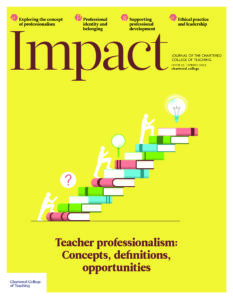Supporting the professional identity of trainee teachers with dyslexia
Written by: Sam Lovatt and Jemima Davey

6 min read
SAM LOVATT, SENIOR LECTURER IN PRIMARY EDUCATION, ST MARY’S UNIVERSITY, UK
JEMIMA DAVEY, SUBJECT LEAD FOR EDUCATION PARTNERSHIPS AND SENIOR LECTURER IN PRIMARY EDUCATION, ST MARY’S UNIVERSITY, UK
Initial teacher training (ITT) is complex and challenging. Routes into teaching consist of two distinct but interrelated parts: centre-based training and school-based placements. For our students, centre-based training consists of time spent on our university campus learning about learning, teaching and the curriculum, whereas school-based training is formed of several placements in a range of partnership schools. The combination of centre-based and school-based training requires students to manage a range of roles, knowledge and tasks (Gray and Colucci-Gray, 2010). In response to these challenges, a project was initiated to support students diagnosed with ADHD and autism, as well as visual, hearing and mobility impairments.
This article focuses on the support designed for students
Join us or sign in now to view the rest of this page
You're viewing this site as a guest, which only allows you to view a limited amount of content.
To view this page and get access to all our resources, join the Chartered College of Teaching (it's free for trainee teachers and half price for ECTs) or log in if you're already a member.
- Baron S (2023) Teaching with a Strength-Based Approach. Abingdon: Routledge.
- Benchetrit R and Katz I (2019) ‘This is my way… I am an ambassador’: Identity voices of teachers with learning disorders. Teaching and Teacher Education 86(6): 1–8.
- British Dyslexia Association (2019) About dyslexia. Available at: www.bdadyslexia.org.uk/dyslexia/about-dyslexia (accessed 19 November 2024).
- Gray D and Colucci-Gray L (2010) Challenges to ITE research in conditions of complexity. Journal of Education for Teaching: International Research and Pedagogy 36(4): 425–439.
- Jacobs L, Collyer E, Lawrence C et al. (2021) ‘I've got something to tell you. I’m dyslexic’: The lived experiences of trainee teachers with dyslexia. Teaching and Teacher Education 104(1): 1–10.
- Müller L-M and Cook V (2024) Revisiting the notion of teacher professionalism: A working paper. Chartered College of Teaching. Available at: https://chartered.college/wp-content/uploads/2024/05/Professionalism-report_2-May.pdf (accessed 7 November 2024).
- Nichols SL, Schutz PA, Rodgers K et al. (2017) Early career teachers’ emotion and emerging teacher identities. Teachers and Teaching 23(4): 406–421.
- Steadman S (2023) Identity. London: Bloomsbury.
- St Mary’s University (SMU) (2024) Supporting students with a declared disability: Dyslexia. Available at: www.stmarys.ac.uk/partnerships/itt-school-experience-handbook/during-school-experience/supporting-trainees-during-school-experience/dyslexia.aspx (accessed 5 November 2024).
- Woodfine C and Warner D (2022) The identity dilemmas of Early Career Teachers from under-represented groups in the UK. Teaching Education 34(3): 335–350.
0
0
votes
Please Rate this content
Please login to comment
0 Comments
Oldest
Newest
Most Voted
Inline Feedbacks
View all comments










